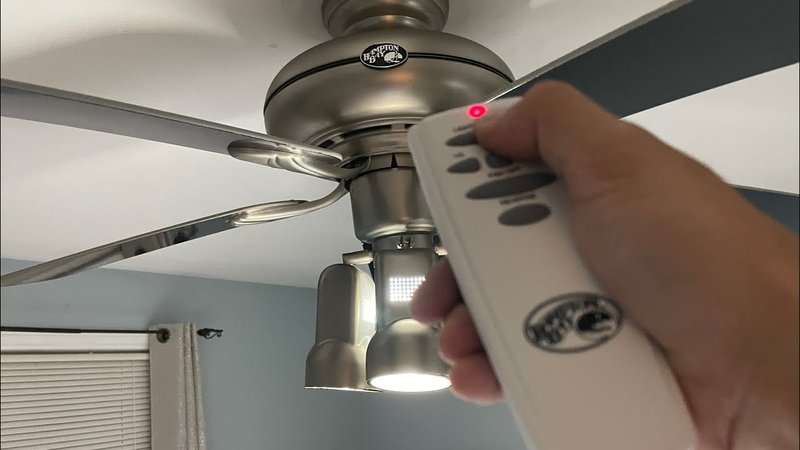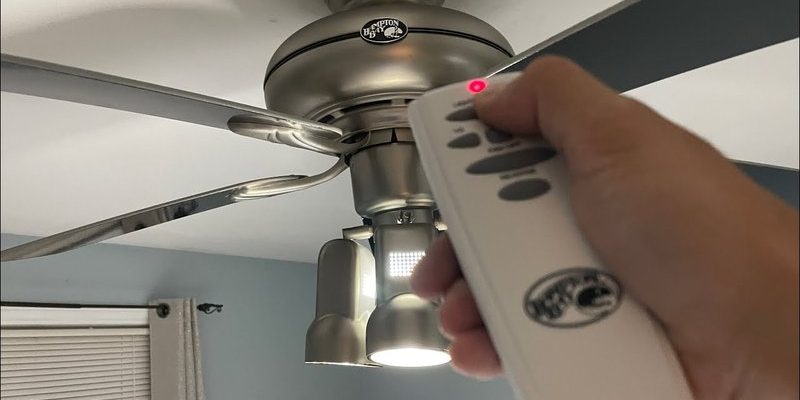
Using a single remote to control multiple ceiling fans seems like a clever shortcut, almost like having a master key for your entire house. But, just like with keys, there’s more under the hood than meets the eye. When it comes to Hampton Bay ceiling fan remotes, the answer isn’t always as simple as “yes” or “no”—it depends on how things are set up inside the fan, the type of remote, and whether you’re okay with a few quirks along the way.
Most Hampton Bay remotes are designed with convenience in mind, syncing wirelessly to the fan’s receiver. But this convenience can turn into confusion if you’re not sure how the signals and codes work. Let’s break down if—and how—you can use one remote to rule them all, and what you should know before giving it a go.
How Hampton Bay Ceiling Fan Remotes Work
Here’s the thing—despite their small size, Hampton Bay fan remotes are pretty sophisticated. They don’t just “point and click” like a TV remote. Instead, they communicate over radio frequencies (RF), sending a specific code to a receiver installed in each ceiling fan.
Inside most Hampton Bay remote kits, you’ll find a tiny set of dip switches. These act like a secret handshake between your remote and the receiver inside your fan. When the codes match, hitting the button turns your fan on, off, or even changes the speed. If the codes don’t match, the fan stays put, blissfully unaware of your remote’s pleas.
Some newer Hampton Bay fans and remotes skip the physical dip switches altogether, instead using digital pairing methods where you sync the remote to the fan electronically. But the key idea stays the same: for the remote to work, it and the fan must “speak” the same code, whether set by switches or digital memory.
Pairing One Remote with Multiple Hampton Bay Fans
You might be wondering, “Can I set all my fans to the same code so one remote controls everything?” In theory—yes. If every receiver inside your Hampton Bay fans has its dip switches (or pairing mode) set to match your one remote, pressing a button will send that command to all fans at once.
But here’s the catch: you’re not getting separate control over each fan. Imagine flipping the light switch in your kitchen and watching every light in the house snap on. Useful sometimes, but awkward if you just want a breeze in one room. This kind of setup is called broadcasting; one signal triggers every receiver on the same code.
If you want individual control—say, different speeds or lights on each fan—you’ll need different codes or remotes. Alternatively, some universal or “multi-zone” systems offer more flexibility, but standard Hampton Bay kits don’t include this feature out of the box.
Understanding Dip Switch Codes and Syncing
Let me explain the dip switch thing a bit more. Inside your remote and each fan’s receiver, you’ll see a row of tiny switches (usually four or five). Each switch can be “up” or “down,” making dozens of unique code combinations. The code you set on the remote must exactly match the code set on each receiver for the system to work.
Here’s how to sync or pair a remote:
- Turn off power to the fan at the breaker (for safety).
- Remove the fan canopy and locate the receiver—the little box connected to the fan wiring.
- Find and set dip switches to your chosen code, making sure both the remote and receiver match.
- Restore power, then test your remote to see if the fan responds.
If you use the same dip switch code in all fans, one remote can trigger them all. But if you want to avoid mix-ups (like accidentally turning on a fan in your bedroom from the living room), set each fan to a unique code.
Digital Pairing: The Modern Hampton Bay Remote
Some newer Hampton Bay remotes dropped the old dip switch method for digital pairing. These remotes usually feature a sync or pair button, and the pairing process involves holding the button until the receiver and remote “find” each other wirelessly. It’s quicker and means fewer tiny switches to break or set.
With digital pairing, it’s still possible to sync one remote with multiple fans—if you intentionally put each fan into pairing mode at the same time. But again, each command goes to every paired fan. If you pair each fan separately with a unique remote, then you keep individual control.
The upside? Digital pairing is more secure and less prone to interference from neighbors using similar remotes. The downside is you can’t just flip a few switches to change codes—you have to repeat the digital sync process.
Limitations and Troubleshooting Multiple Fan Control
If you’re thinking of controlling all your Hampton Bay ceiling fans with one remote, here are a few things to keep in mind:
- No separate zone control. All paired fans do the same thing—no exceptions.
- Signal interference. In rare cases, signals might reach fans in neighboring rooms, especially if your walls are thin or the house is open-plan.
- Power cycling resets. Sometimes, after a power outage, your fans might forget their pairing or code. You’ll have to re-sync them to your remote.
- Battery quirks. A weak or dying remote battery can cause spotty performance or random fan behavior. Always check this first when troubleshooting.
If things stop working, check the dip switch settings, make sure the batteries are fresh, and ensure you’re not dealing with interference from other RF devices or remotes nearby. Sometimes, simply resetting the pairing or power cycling both fan and remote fixes stubborn problems.
Comparing Hampton Bay Remotes to Universal Fan Remotes
If the thought of all-or-nothing fan control feels limiting, you might want to consider universal ceiling fan remotes. These remotes are designed to work with a wide range of brands, not just Hampton Bay. Some allow you to control fans in different “zones,” giving you more flexibility for larger homes.
But, and here’s my two cents, universal remotes aren’t always plug-and-play with Hampton Bay fans. You’ll want to double-check compatibility, especially the receiver type and frequency. Sometimes, you’ll need to swap in a new universal receiver (a small box that fits inside your fan canopy) to make it all work. That’s a bit more involved than just flipping switches.
On the other hand, Hampton Bay brand-specific remotes are straightforward. They’re made to match the code system or digital sync used by your fan. If you’re not comfortable with wiring or troubleshooting, sticking to the original Hampton Bay equipment can save you time and stress.
When Does Using One Remote Make Sense?
You might ask, “When would I actually WANT one remote for all my fans?” The answer depends on your living situation. Here are a few scenarios:
- Large open spaces. Think great rooms or connected living/dining/kitchen areas. One remote can instantly set the mood for the entire space.
- Mobility issues. For folks who have difficulty moving around, one remote makes controlling multiple fans much easier.
- Simple setups. Vacation homes or cabins where you just want on/off control and don’t need to fine-tune each fan.
For most homes, though, separate controls tend to make daily life smoother. There’s nothing worse than waking up to a gust of wind in every room because someone hit the remote in the wrong spot.
Installing and Resetting Hampton Bay Ceiling Fan Remotes
Let’s walk through the basics of installing a Hampton Bay remote or resetting codes:
- Installation: Carefully remove the fan canopy and connect the receiver between your ceiling wiring and the fan wires. Secure everything, set your dip switches or digital pairing, then mount the canopy back.
- Resetting codes: For dip switch models, simply change the code and make sure the remote and receiver match. For digital remotes, follow the manufacturer’s sync instructions—usually involving holding a pairing button until you hear a beep or see a light flash.
If the remote stops syncing or works sporadically, double-check for loose wiring, weak batteries, or interference from nearby electronics. Replacing the battery is fast and often solves random glitches.
Final Thoughts on Using a Single Remote for Hampton Bay Fans
Controlling multiple Hampton Bay ceiling fans with one remote is possible, but only if you’re okay with treating them as a group—no individual settings allowed. Matching dip switch codes or syncing via digital pairing lets you wield one remote like a conductor’s baton, but at the price of flexibility.
If you crave separate control in every room, stick to individual remotes or look into advanced universal systems. For folks who prize simplicity and just want to cut down on clutter, syncing multiple fans to a single Hampton Bay remote does the job—as long as you know what you’re signing up for.
Like so many things in life, the trick comes down to balancing convenience with control. Choose the setup that feels right for your home, and don’t be afraid to experiment. Worst case, you’ll need to flip a few switches—or, at most, swap out a battery or two.
